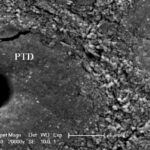
The prevalence of dentine hypersensitivity is reported to be between 1.3% to 92% (Dental Elf – 23rd Jan 2019). Dentine hypersensitivity is defined as a short sharp pain that originates from exposed dentine in response to external stimuli such as tactile, thermal, osmotic, chemical, or evaporative stimuli that cannot be attributed to any other dental cause. A widely accepted theory for the cause of dentine hypersensitivity is the hydrodynamic theory. This theory states that different stimuli act on exposed dentine which induces fluid flow within dentinal tubules and activates nerve endings in the pulp resulting in pain. With this theory in mind, the ideal treatment for dentine hypersensitivity should either block neural transmission to the pulp or occlude the dentinal tubules. Bioactive glass and hydroxyapatite are among the primary bioactive materials with the potential to both occlude exposed dentine tubules and remineralise the tooth structure.
The aim of this systematic review was to evaluate the effects of using bioactive glass and hydroxyapatite in occluding exposed dentine tubules.
Methods
This review followed PRISMA guidelines and searches were conducted in PubMed/Medline, Web of Sciences, and Embase. The authors report that due to insufficient clinical studies, only in vitro studies that investigated the effects of bioactive glass and/or hydroxyapatite on the closure of dentine tubules were considered in this review. Two investigators independently screened potentially relevant studies and extracted data. The methodological quality of each study was determined by evaluating the description of randomization of teeth, sample preparation, presence of caries, a control group, blinding, statistical analysis, and outcome measures. A narrative summary of the findings was presented.
Results
- 35 in vitro studies were included.
- A total of 238 and 171 samples were collected to evaluate the ability to occlude the dentinal tubules by bioactive glass and hydroxyapatite respectively.
- In all studies dentine disc models were used to test the desensitising ingredients and different assessment techniques, such as electron microscopy, laser scanning, and X-ray spectroscopy, were used to examine the dentine tubule occlusion.
- The studies revealed a low risk of bias in randomization of teeth, sample preparation, caries, control group, statistical analysis, and outcomes
- All studies demonstrated the hydroxyapatite/bioactive glasses potential in dentin tubule occlusion compared to control and other topical treatments.
Conclusions
The authors concluded: –
The results of the current systematic review showed that bioactive glass and hydroxyapatite could effectively occlude the dentinal tubules. Thus, desensitizing agents containing bioactive glass and hydroxyapatite can be used for DH management. However, long-term clinical trial follow-ups are required before a definitive decision and recommendation can be made.
Comments
There are several systematic reviews of treatments for dentine hypersensitivity (Dental Elf- Dentine Hypersensitivity blogs). There is existing literature to support that bioactive glass can be effective in the management of dentine hypersensitivity. A 2021 review published by Freitas et al (Dental Elf – 8th Dec 2021) included 15 studies that compared bioactive toothpaste against a placebo and concluded that bioactive compounds can be used for the treatment of dentine hypersensitivity. This review has a different approach in that it aims to examine the ability of bioactive glass/hydroxyapatite in occluding dentinal tubules. The authors report that 22 studies within the review used a suitable negative control which can help the researchers assess the effect of the desensitizing ingredient and can add some credibility to the findings. It should be considered, however, that across all studies there were differences in sample preparation, storage, and dentine analysis technique meaning the results should be interpreted with caution. It should be acknowledged that this review reports results from dentine tubule preparation and occlusion in an in-vitro setting which is very different to the oral cavity of a patient in which moisture control, patient cooperation and lighting all impact treatment application. Overall, this review provides some evidence that bioactive glass/hydroxyapatite are effective in occluding dentinal tubules in an in vitro setting, but further research, ideally a long-term clinical trial, is required to develop the most effective way to deliver this to patients.
Links
Primary paper
Behzadi S, Mohammadi Y, Rezaei-Soufi L, Farmany A. Occlusion effects of bioactive glass and hydroxyapatite on dentinal tubules: a systematic review. Clin Oral Investig. 2022 Oct;26(10):6061-6078. doi: 10.1007/s00784-022-04639-y. Epub 2022 Jul 25. PMID: 35871701.
Other references
Dental Elf – 23rd Jan 2019
Dental Elf, 8th Dec 2021
Dental Elf – Hypersensitivity blogs
Picture Credits
Pinkmanggis, CC BY-SA 4.0, via Wikimedia Commons
